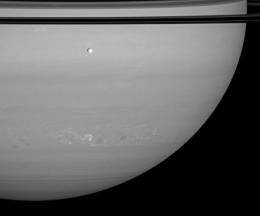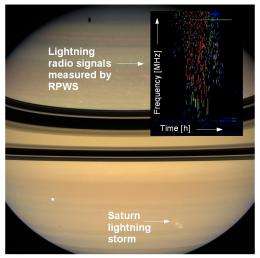Longest lightning storm on Saturn breaks Solar System record

A powerful lightning storm in Saturn’s atmosphere that began in mid-January 2009 has become the Solar System’s longest continuously observed thunderstorm. It broke the record duration of 7.5 months set by another thunderstorm observed on Saturn by NASA’s Cassini spacecraft between November 2007 and July 2008.
The observations of the thunderstorm will be presented by Dr Georg Fischer of the Austrian Academy of Sciences at the European Planetary Science Congress in Potsdam, Germany, on Tuesday 15 September.
The current thunderstorm on Saturn is the ninth that has been measured since Cassini swung into orbit around Saturn in July 2004. Lightning discharges in Saturn's atmosphere emit very powerful radio waves, which are measured by the antennas and receivers of the Cassini Radio and Plasma Wave Science (RPWS) instrument. The radio waves are about 10 000 times stronger than their terrestrial counterparts and originate from huge thunderstorms in Saturn's atmosphere with diameters around 3000 km.
Dr Fischer said, “These lightning storms are not only astonishing for their power and longevity, the radio waves that they emit are also useful for studying Saturn's ionosphere, the charged layer that surrounds the planet a few thousand kilometres above the cloud tops. The radio waves have to cross the ionosphere to get to Cassini and thereby act as a natural tool to probe the structure of the layer and the levels of ionisation in different regions.”

The observations of Saturn lightning using the Cassini RPWS instrument are being carried out by an international team of scientists from Austria, the US and France. Results have confirmed previous studies of the Voyager spacecraft indicating that levels of ionisation are approximately 100 times higher on the day-side than the night side of Saturn’s ionosphere.
Lightning storms on Saturn usually occur in a region that nicknamed "Storm Alley" by scientists, which lies 35 degrees south of Saturn’s equator.
Dr Fischer commented, “The reason why we see lightning in this peculiar location is not completely clear. It could be that this latitude is one of the few places in Saturn’s atmosphere that allow large-scale vertical convection of water clouds, which is necessary for thunderstorms to develop. However, it may be a seasonal effect. Voyager observed lightning storms near the equator, so now that Saturn has passed its equinox on 11 August, we may see the storms move back to equatorial latitudes.”
Saturn’s role as the source of lightning was given added confirmation during Cassini’s last close flyby of Titan on August 25. During the half hour that Cassini’s view of Saturn was obscured by Titan, no lightning was observed. “Although we know from Cassini images where Saturn lightning comes from, this unique event was another nice proof for their origin.” said Dr Fischer.
Provided by Europlanet

















